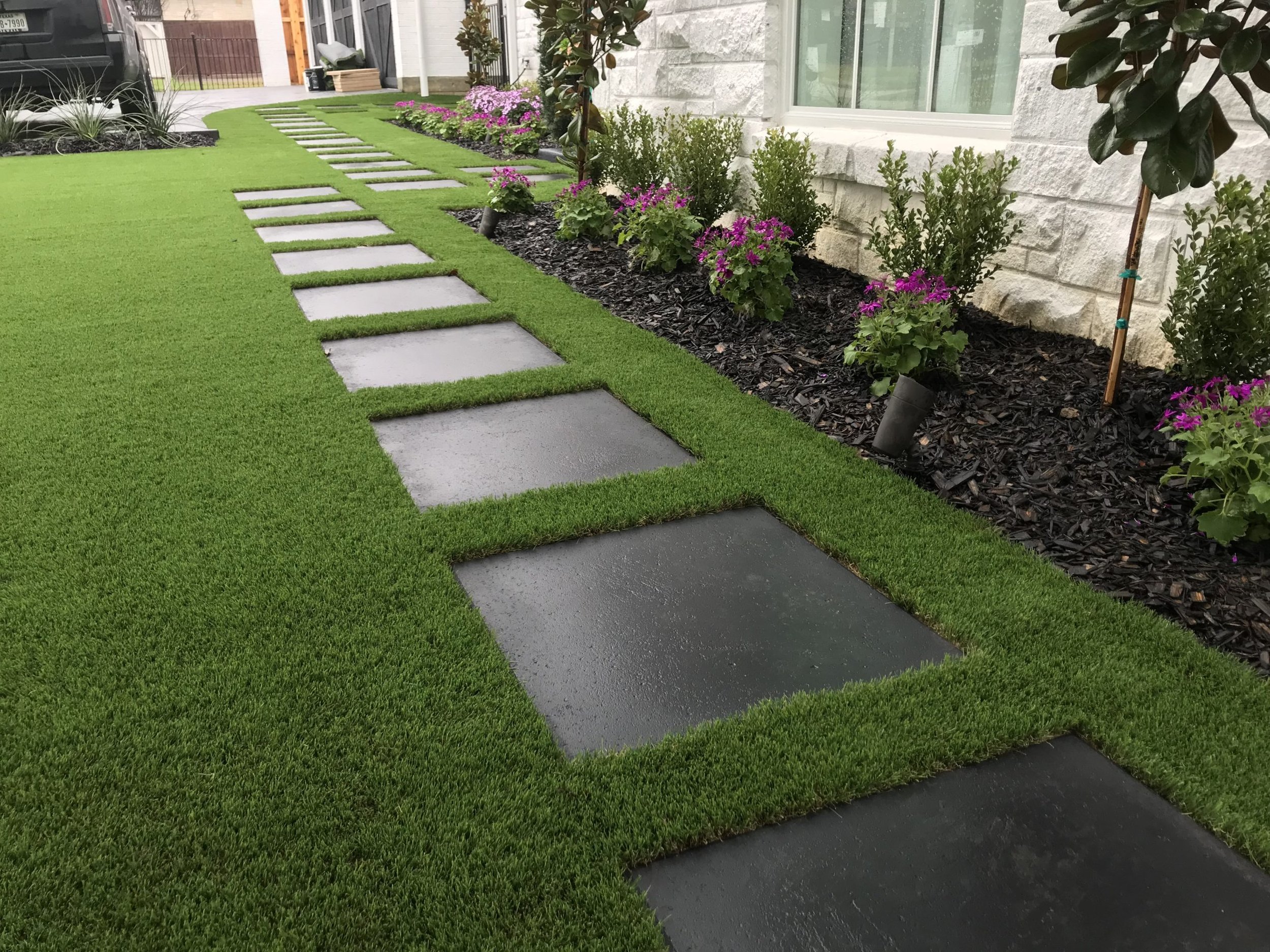See Why Homeowners Prefer Synthetic Grass for Lasting Landscaping Practices
As home owners significantly focus on sustainability in landscape design, artificial turf has become an engaging alternative to standard lawn. Its capacity to save water, reduce upkeep initiatives, and lessen environmental impact positions it as a useful option for those seeking green solutions. The visual charm and flexibility of artificial lawn cater to varied layout preferences. Nevertheless, the ramifications of this shift prolong past plain benefit and visual appeals, prompting a more detailed assessment of how these choices influence broader environmental results. What stays to be checked out is the complete extent of advantages that man-made turf can offer to home owners and the environment alike.
Water Preservation Conveniences
One of one of the most substantial benefits of synthetic grass is its role in water preservation. Typical grass lawns require significant quantities of water to keep their rich appearance, usually bring about overuse of regional water resources, particularly in deserts. On the other hand, synthetic grass removes this need completely, as it does not call for watering. This not only preserves water yet also decreases the stress on local water systems, particularly throughout drought problems.
In addition, the installation of synthetic grass can add to a more lasting landscape. Homeowners can substantially decrease their water costs, permitting reallocation of resources to other environmental efforts or family usages. Additionally, synthetic grass is created to withstand numerous climatic conditions without the requirement for additional watering, making it an ideal choice for areas facing water shortage.
The ecological advantages expand past immediate water financial savings. By minimizing water usage, synthetic grass helps to reduce the influences of environment adjustment, protecting important ecological communities that are endangered by excessive water removal. As lasting landscape design techniques gain traction, synthetic grass emerges as a responsible choice for homeowners looking for to develop environment-friendly exterior spaces.
Minimized Upkeep Initiatives
Man-made lawn considerably lowers upkeep efforts contrasted to conventional yard lawns. With artificial lawn, home owners can get rid of the taxing tasks connected with natural landscape design, such as mowing, fertilizing, and weeding. This not only saves valuable time yet likewise minimizes physical labor, making lawn treatment obtainable for individuals of every ages.
Among the most remarkable advantages is the lack of normal mowing. Traditional grass need constant trimming to preserve a cosmetically pleasing height, whereas fabricated grass remains regularly rich without the need for cutting. Additionally, house owners no longer require to use pesticides or plant foods, which are often needed to keep natural lawn healthy. This change not only lightens the workload however additionally advertises a neater, more consistent look year-round.
Furthermore, man-made turf is resistant and sturdy, needing minimal maintenance beyond occasional brushing and rinsing to eliminate particles. This convenience of upkeep permits property owners to appreciate their outside areas without the continuous concern of upkeep, giving even more time for leisure and family members tasks. Ultimately, the minimized upkeep initiatives connected with synthetic grass make it an attractive option for those looking for a low-maintenance, visually appealing landscape.

Ecological Impact Decrease
There is an expanding acknowledgment of the ecological benefits related to man-made grass, specifically in regards to water preservation and reduced chemical usage. Conventional yards need substantial quantities of water, specifically in drought-prone areas, leading to increased strain on their explanation local water resources. In contrast, synthetic grass gets rid of the requirement for irrigation, dramatically minimizing water intake and advertising sustainability.
Furthermore, traditional yard maintenance typically includes the application of herbicides, chemicals, and plant foods, which can add to soil and water contamination. Synthetic turf mitigates this ecological danger by needing very little upkeep and virtually removing the demand for dangerous chemicals. This not just enhances soil health yet likewise safeguards local communities from harmful runoff.
In addition, the manufacturing of natural grass yards normally involves the usage of fossil gas for trimming and landscape design devices, additional contributing to greenhouse gas emissions. By choosing synthetic grass, house owners can dramatically lower their carbon footprint linked with grass treatment tasks.
Aesthetic Allure and Convenience
Along with its ecological advantages, synthetic lawn uses substantial aesthetic charm and versatility for landscape design. Home owners can accomplish a lavish, green appearance year-round, removing the seasonal fluctuations typically linked with natural turf. This consistent aesthetic not just boosts the visual charm of a residential or commercial property yet also adds to a refined and well-kept look.
Additionally, synthetic grass is readily available in a selection of appearances, colors, and styles, enabling modification to fit private preferences and style motifs - Arizona turf. Whether used in residential gardens, industrial areas, or leisure areas, it can seamlessly integrate right into varied landscaping designs, from modern minimal to lavish tropical settings
The versatility of synthetic grass expands beyond mere look; it can be mounted in different locations, consisting of roofs, outdoor patios, and even interior areas, creating possibilities for special landscaping solutions. In addition, it is appropriate for a variety of activities, from youngsters's backyard to pet-friendly environments, providing capability without jeopardizing design.
Inevitably, the aesthetic allure and adaptability of synthetic lawn make it an appealing option for home owners seeking lasting landscaping remedies that do not compromise beauty for ecological responsibility.

Long-Term Expense Financial Savings
Among one of the most engaging benefits of synthetic grass is its possibility for lasting cost savings. Unlike natural grass, which requires regular maintenance-- including mowing, watering, feeding, and parasite control-- synthetic grass considerably decreases these ongoing expenses. Property owners can save a considerable amount on description water bills, especially in regions where water deficiency is a pushing concern. The removal of yard care services further why not look here contributes to economic cost savings, as there is no demand for customized devices or labor.
Additionally, synthetic turf has a life-span of 15 to 25 years, relying on its high quality and usage. This sturdiness reduces replacement costs, making it a more economical selection over time. The first investment in fabricated lawn can frequently be redeemed with the savings built up over time.
While the upfront price may appear higher compared to turf setup, the advancing financial savings from lowered maintenance and water usage commonly surpass these first expenditures. Ultimately, the fostering of synthetic grass not just promotes a sustainable landscaping option yet likewise provides homeowners an economically smart alternative that aligns with long-term budgeting goals.
Final Thought
Fabricated turf emerges as an engaging alternative for sustainable landscaping, offering substantial benefits in water conservation, minimized upkeep efforts, and decreased environmental impact. As communities increasingly focus on eco pleasant techniques, the fostering of artificial lawn stands for a modern step toward attaining lasting and resistant landscapes.
Furthermore, man-made grass is made to hold up against numerous weather problems without the requirement for additional watering, making it a suitable option for regions encountering water shortage. (Arizona turf)

Artificial lawn arises as a compelling option for lasting landscape design, using considerable advantages in water preservation, minimized maintenance efforts, and lessened ecological effect.